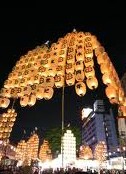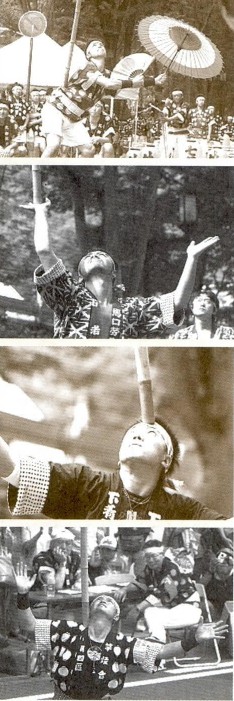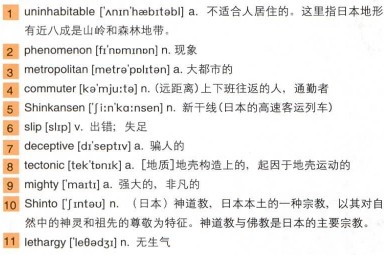美式发音 适合模仿
 This 1)uninhabitable landscape has forced the population down into the coastal areas…and by doing so, created a futuristic 2)phenomenon. Tokyo, the capital, 35 million people live and work here. It’s the largest 3)metropolitan area in the world. Getting this vast sea of 4)commuters to and from work requires a vast and efficient transport network. Fifty thousand taxis, a subway system that moves eight million people a day. The 5)Shinkansen bullet trains run so precisely that over a year their timetable 6)slips by just 36 seconds. But the most surprising commuter route is by air. The domestic flight from Saporo to Tokyo is the busiest air route in the world, carrying almost 10 million commuters a year. Organizing so many passengers requires futuristic thinking. Instead of old-fashioned tickets, why not use your cell phone?
This 1)uninhabitable landscape has forced the population down into the coastal areas…and by doing so, created a futuristic 2)phenomenon. Tokyo, the capital, 35 million people live and work here. It’s the largest 3)metropolitan area in the world. Getting this vast sea of 4)commuters to and from work requires a vast and efficient transport network. Fifty thousand taxis, a subway system that moves eight million people a day. The 5)Shinkansen bullet trains run so precisely that over a year their timetable 6)slips by just 36 seconds. But the most surprising commuter route is by air. The domestic flight from Saporo to Tokyo is the busiest air route in the world, carrying almost 10 million commuters a year. Organizing so many passengers requires futuristic thinking. Instead of old-fashioned tickets, why not use your cell phone?  Masters of new technology, the Japanese also share a deep connection with the natural world. But the country’s beauty is 7)deceptive. Japan runs along the Pacific “Ring of Fire.” This dangerous intersection of five 8)tectonic plates triggers more than a thousand earthquakes a year. There are 186 volcanoes, a third of them still active today, including the 9)mightiest of them all, Mount Fuji, the gateway between Earth and Heaven.
Masters of new technology, the Japanese also share a deep connection with the natural world. But the country’s beauty is 7)deceptive. Japan runs along the Pacific “Ring of Fire.” This dangerous intersection of five 8)tectonic plates triggers more than a thousand earthquakes a year. There are 186 volcanoes, a third of them still active today, including the 9)mightiest of them all, Mount Fuji, the gateway between Earth and Heaven.
Up in the mountains spring has turned to summer. It’s the season of maturity and growing up, when Japan’s vulnerable nature bursts spectacularly into life.
Summer is also the season of festivals. To the Japanese, festivals are a link between humans and the gods. Many have their origins in the native religion, 10)Shinto, and mark stages in the rice-growing cycle. Summer festivals were created to snap people out of a 11)lethargy brought on by the heat of the summer and to prepare them for the hard work of the harvest. At the Kanto Festival in Akita, every lantern, balanced 20 feet high, represents a grain of rice. It’s just one of hundreds of colourful 12)processions thanking the gods for their 13)generosity.
这种不适合人居住的地形,迫使日本人都往滨海地区聚拢……这便促成了一种超凡的景象——日本首都东京,三千五百万人在这里居住和工作。这是全球最大的都会。让庞大的上班一族顺利上、下班,需要庞大又高效的运输网络。这里有五万辆出租车,城市地铁网络系统每天能运送八百万人次。新干线子弹列车非常精准。一年来,其时刻表只误点36秒。但最神奇的通勤路线是航空。从札幌到东京的国内航线是全球最繁忙的,每年运载的通勤客接近一千万人次。替这么多乘客作安排,需要具有前瞻性的思维。与其用旧时代的车票,何不转用手机呢?
日本人精通新科技,但同时也跟大自然有着深远的联系。但这个国家的美有所隐藏。日本坐落在太平洋的火山带上。这个有五大板块交汇的危险地带,每年引发一千多次地震。共有186座火山,其中三分之一还是活火山,包括最宏伟的富士山——尘世与天庭之间的大门。
在山间,春天渐渐变成了夏天。这是万物茁壮成长、日渐成熟的季节,日本脆弱的大自然顿时变得生机勃勃。
夏天还是节庆的时节。对日本人来说,节庆就是人与神之间的纽带。许多节庆源自本土宗教神道教,标志着稻的不同生长阶段。设立夏日节庆为的是让人摆脱炎炎夏日所带来的怠倦,为忙碌的收割工作作好准备。在秋田的竿灯祭上,用20英尺长的杆子顶着的灯笼每一个都代表一粒稻米。这只是数百个缤纷巡游之一,以感谢神的慷慨。
翻译:立及夕


